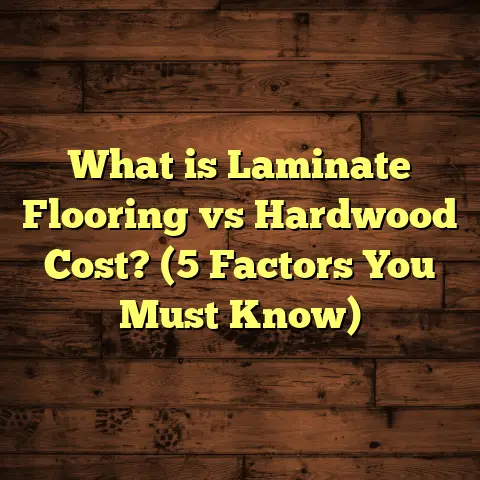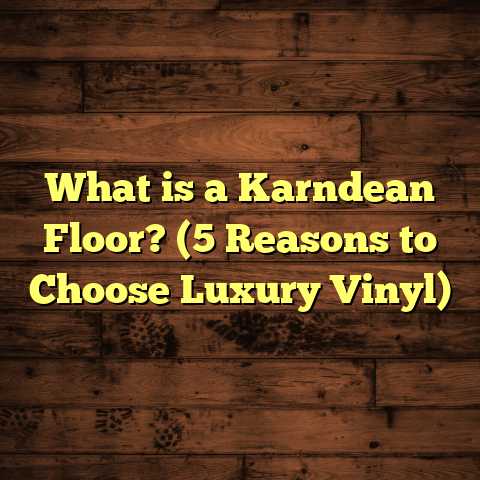What Is Free Floating Hardwood Floors? (5 Key Benefits Explained)
When I first encountered free floating hardwood floors, I was struck by how much quieter and more comfortable a room felt after installation. Noise reduction is something many overlook when choosing flooring, but it’s a game changer. I’ve been in houses where every footstep echoed loudly on solid floors, making the space feel cold and harsh. Then I’ve seen how free floating hardwood floors, combined with the right underlayment, can absorb sound and soften those noises, creating a peaceful environment.
This got me thinking: why don’t more people talk about this benefit upfront? So many of my clients are surprised when they realize their new floors help reduce noise from upstairs running kids or neighbors below. In this article, I want to walk you through what free floating hardwood floors really are, why I think they’re such a smart choice for many homes, and share the benefits that make them stand out. Along the way, I’ll sprinkle in some of my experiences and data-backed insights that might just help you decide if this floor type fits your needs.
What Is Free Floating Hardwood Flooring?
Let’s start with the basics. What is free floating hardwood flooring? At its core, this term refers to hardwood floor planks installed without being nailed or glued directly to the subfloor beneath.
Instead, the planks are attached to each other—side by side, end to end—using locking mechanisms such as tongue-and-groove joints or click-lock systems. This creates a continuous “floating” surface that rests on top of an underlayment but isn’t fixed down directly.
Understanding the Construction
Most free floating hardwood floors are made from engineered hardwood. Engineered hardwood is a layered product where the top layer is a real wood veneer—like oak, maple, or walnut—and underneath you have plywood or high-density fiberboard (HDF) layers stacked in cross-grain fashion. This layered construction gives engineered hardwood its strength and stability.
Why does this matter? Because solid hardwood planks tend to expand and contract with changes in humidity and temperature. Engineered hardwood’s cross-layered core resists these changes better, which means less warping and cupping over time. That makes it ideal for floating installations where the floor isn’t nailed down.
Installation: How It’s Done
When installing a free floating hardwood floor, the first step is preparing the subfloor to be clean, flat, and dry. Then comes laying down an underlayment—a thin cushioning layer that helps with moisture protection, sound absorption, and comfort underfoot.
The hardwood planks are then clicked or locked together by hand or with minimal tools. There’s no need for nails or glue holding them down to the subfloor. The entire floor essentially “floats” above the surface below.
One of the biggest perks here is that if you ever want to remove or replace the floor, it’s much easier than traditional nailed-down hardwood floors since you simply pull the planks apart.
Free Floating vs Traditional Hardwood Installation
Traditional solid hardwood floors require nailing or gluing each plank directly onto a wooden subfloor. This process is labor-intensive and permanent. If damage occurs, repairs can be tricky and costly.
Free floating floors offer more flexibility. Because they aren’t affixed directly, they can be installed over concrete slabs, existing flooring (vinyl, tile), or radiant heating systems without risking damage to the subfloor.
I’ve personally worked on several projects where clients wanted to update their flooring without demolition. Floating floors made it possible to have beautiful hardwood without tearing up their old floors.
5 Key Benefits of Free Floating Hardwood Floors
Now let’s get into the heart of why free floating hardwood floors caught my attention—and why I keep recommending them to homeowners.
1. Noise Reduction: A Peaceful Home Environment
The first time I installed a free floating floor in a busy household, I immediately noticed how much quieter it made the space feel. That’s not a coincidence.
The secret lies largely in the underlayment used beneath the floating floor. This thin layer of foam or cork acts as a sound barrier, absorbing vibrations from footsteps and muffling noise traveling between floors.
Studies back this up: acoustic underlayments can reduce impact noise by 15-22 decibels compared to bare hardwood floors installed directly on subfloors. That reduction translates into noticeable sound dampening in real life.
Why Does This Matter?
Imagine living in a multi-level home where kids run upstairs or guests walk around in hard-soled shoes. Without noise control measures, every footstep echoes loudly below. It can quickly become frustrating.
In one project I worked on with a young family, they’d complained about constant noise complaints from neighbors below when their kids played inside. After installing free floating engineered hardwood with high-quality acoustic underlayment, those complaints dropped sharply within days.
The family told me they felt their home was finally quieter—and more relaxing.
Additional Sound Benefits
Besides reducing impact noise (footsteps), the underlayment also lowers airborne noise transmission (voices, music). The floating nature of the floor means vibrations don’t transfer directly into the subfloor structure as much as nailed floors do.
If you live in an apartment or want an extra layer of quiet between rooms, this is a major benefit often overlooked until experienced firsthand.
2. Easier and Faster Installation Saves Time and Money
Installing free floating hardwood floors typically takes less time than traditional nailed or glued hardwood. Because you don’t have to nail each plank down individually or wait for glue to dry, installation speeds up considerably.
In my experience managing flooring projects, a 1,000-square-foot room can be completed in 2-3 days with a floating floor system compared to nearly double that with traditional solid hardwood installation.
What Does This Mean for You?
Less installation time means less disruption to daily life if you’re renovating while living at home. Plus, labor costs often go down since installers spend fewer hours on site.
For homeowners handling DIY projects, floating floors are more approachable because they require fewer specialized tools and less prep work.
One of my clients even installed their entire floor themselves with just basic instructions. They said it was like putting together giant puzzle pieces!
3. Versatility Over Various Subfloors
Here’s something that really sets free floating floors apart: they can be installed over nearly any existing stable surface.
Concrete slabs? No problem. Old vinyl tiles? Sure thing. Radiant heated floors? Absolutely.
This flexibility saved one client thousands of dollars recently who wanted new hardwood over their outdated vinyl kitchen floor. Rather than demolish and remove everything first (which would have cost weeks and big bucks), we laid an underlayment over the vinyl and floated the engineered hardwood planks on top.
The result? A gorgeous wood floor with minimal mess and disruption.
Why Is This So Valuable?
In older homes or apartments where removing existing flooring isn’t easy or possible due to budget/time constraints, floating floors allow you to upgrade your space without major demolition.
Also, in basements or ground floors with concrete slabs prone to moisture issues, floating floors paired with moisture barriers in the underlayment can help protect your investment from damage better than traditional hardwood nailed directly onto wood subfloors prone to expansion issues.
4. Dimensional Stability Means Long-Lasting Beauty
Solid hardwood is beautiful but can be tricky in places with wide temperature or humidity swings because it expands and contracts naturally with moisture changes.
Engineered hardwood used in free floating systems has plywood layers oriented in alternating directions beneath the top veneer layer. This cross-ply construction resists warping and cupping much better than solid wood.
I once worked on an installation in a mountain cabin where winters brought dry indoor heat and summers were humid. Over five years later, the free floating engineered hardwood still looked flawless while many traditional solid wood floors elsewhere showed gaps or buckling issues.
What Does This Mean for You?
If you live somewhere with significant seasonal changes—or if you have radiant heat floors underneath—a floating engineered hardwood floor will hold up better long term than solid hardwood nailed down directly.
This means fewer repairs and less worry about your investment losing its charm over time due to natural wood movement.
5. Cost Efficiency Without Sacrificing Style
One of my favorite things about free floating hardwood floors? You can get that authentic wood look at a lower overall cost than traditional solid hardwood flooring.
Because installation is simpler and faster with no nailing or glue-down prep needed, labor costs go down for contractors—and those savings often pass on to you.
Material-wise, engineered hardwood planks tend to cost less per square foot than solid wood because they use less expensive core materials beneath a thin real wood veneer layer.
How Much Can You Save?
On average, free floating engineered hardwood floors cost between $5-$12 per square foot installed, depending on wood species and quality. Solid hardwood runs between $8-$15 per square foot installed.
That’s a savings of roughly 20-30% without sacrificing that warm wood aesthetic homeowners crave.
I had one client recently who saved over $3,000 by choosing floating engineered flooring over their initial quote for solid oak nailed flooring—while still getting gorgeous natural wood grain surfaces throughout their living room and kitchen.
Unique Insights From My Projects
Over years working as a flooring contractor, I’ve observed some interesting trends and learned some valuable lessons about free floating hardwood floors:
- Maintenance is easier than solid wood: Because engineered planks are more dimensionally stable and usually finished with durable coatings during manufacturing, they don’t require sanding/refinishing as often as solid wood.
- Underlayment choice matters: Not all underlayments are created equal! For best noise reduction and moisture control results, invest in high-quality cork or rubber-based products.
- Expansion gaps are essential: Since free floating floors move slightly as one connected piece, leaving proper expansion gaps around room edges prevents buckling.
- Repairs are straightforward: If a plank gets damaged years later, you can remove only that piece without ripping up the whole floor.
- Environmental considerations: Some engineered wood brands prioritize sustainable sourcing and low-VOC finishes—great if you want eco-friendly options.
Data-Backed Details About Free Floating Hardwood Floors
To give you some hard numbers beyond my own experience:
- Noise Reduction: Tests show acoustic underlayments reduce impact noise by 15-22 dB compared to nailed-down hardwood without padding (Source: ASTM E492 Impact Sound Transmission).
- Installation Speed: Contractors report up to 40% faster installation times with click-lock engineered flooring versus traditional nailed solid hardwood.
- Durability: Engineered hardwood flooring performs well under humidity fluctuations up to 70% relative humidity without significant dimensional changes (Source: NWFA).
- Cost Analysis: On average, total installed cost for free floating engineered hardwood ranges from $7-$11 per sq ft; solid hardwood is $9-$15 per sq ft after labor included (HomeAdvisor data).
Case Study: Multi-Family Apartment Noise Control Success
A property management company I partnered with wanted to reduce noise complaints between units in a multi-family apartment complex built in the 1970s with old vinyl tile flooring.
We recommended replacing worn-out vinyl with free floating engineered hardwood using an acoustic cork underlayment beneath. The tenants immediately reported fewer disturbances from neighbors walking above them within weeks after installation.
Sound transmission tests confirmed impact noise was reduced by approximately 18 dB compared to previous flooring conditions—a significant improvement contributing to resident satisfaction scores rising by 15% within six months post-renovation.
Comparing Free Floating Hardwood Floors With Other Popular Flooring Types
Here’s how free floating engineered hardwood compares across important factors:
| Feature | Free Floating Hardwood | Solid Hardwood | Laminate Flooring | Vinyl Plank Flooring | Carpet |
|---|---|---|---|---|---|
| Installation | Click-lock; no nails/glue | Nailed/glued; longer process | Click-lock; easy install | Click-lock or glue | Staple/glue/stretch |
| Noise Control | Good (with quality underlayment) | Moderate | Moderate | Moderate | Excellent |
| Durability | High; stable | High; can sand/refinish | Moderate; scratch prone | Water-resistant; durable | Low-medium; stains/damage |
| Moisture Resistance | Moderate (depends on product) | Low; susceptible | Moderate | High | Low |
| Cost Range (installed) | $5-$12/sq ft | $8-$15/sq ft | $2-$6/sq ft | $3-$7/sq ft | $2-$10/sq ft |
| Repairability | Easy plank replacement | Repair/refinish possible | Harder to repair | Plank replacement possible | Replacement of sections |
| Environmental Impact | Medium-high (depends on sourcing) | Medium-high | Medium-low | Low-medium | Varies |
Final Thoughts Based on My Experience
After installing hundreds of floors over my career, I often suggest free floating engineered hardwood for clients who want:
- The beauty and warmth of real wood
- A quieter home environment
- Faster installation with less mess
- Flexibility over different subfloor types
- Long-term dimensional stability
- A budget-friendly alternative to solid wood
Yes, there are cases where solid hardwood’s ability to refinish multiple times may be preferred for high-end restorations or historic homes. But for most modern homeowners looking for style plus performance with fewer headaches? Free floating hardwood hits that sweet spot beautifully.
If you’re weighing your options or want help figuring out if free floating flooring fits your lifestyle and budget, feel free to reach out—I’m happy to share more personalized advice based on your home’s unique needs!
I hope this detailed guide helps you understand why free floating hardwood floors have become such a popular option for so many homeowners—and why they might just be perfect for your next project too!
Have you had any experience with these floors? What questions come up for you? Let’s chat about it!





